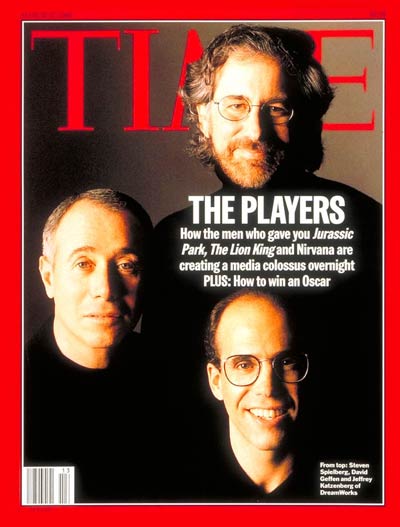
Starting a major Hollywood studio isn’t easy—but for a moment 20 years ago, Steven Spielberg, Jeffrey Katzenberg and David Geffen made it look that way.
On the March 27, 1995, cover of TIME, the three men, collectively known as SKG, posed together under the headline “The Players”; the Oscar-winning director, the record-industry legend and the executive had joined forces (and pooled cash) the year prior to create a company, DreamWorks, that had not yet actually produced anything. No matter! The trio all had sterling track records (Spielberg was coming off the double success of Jurassic Park and Schindler’s List in 1993) and the sheer brio of it made their coming-together newsworthy.
“I guarantee that, when their first film premieres, everyone will say, ‘This is it? This is what these three geniuses have come up with?’,” Tom Hanks, friend to all three men, said in Richard Corliss’ TIME cover story. But at the time, that was all in the future. What underpins TIME’s 1995 coverage of DreamWorks is a sense of just how rare it is for a new force to rise in a Hollywood governed by a set of old, ossified studios. DreamWorks obtained investments, Corliss wrote, based on the hope that it would be “the prototype plugged-in multimedia company of the new millennium.” That it ultimately spent about ten years as an independent entity, largely producing traditional, mid-budget films rather than creating synergistic, plugged-in entertainments is unsurprising in retrospect—but TIME’s in-the-moment exuberance is completely understandable. After all, a new studio is something rare, and something that’s only grown rarer.
SKG didn’t spur imitators among independent producers, which is hardly surprising. Few people with the assets to start a studio, and the trustworthiness to obtain an even bigger line of credit to bankroll it going forward, need the trouble that Corliss’ piece hinted was ahead for SKG. “At DreamWorks, Katzenberg is a man with a mission; the other two are in it for the fun, which could wear thin quickly,” he wrote. But it seems, from the outside, that the studio’s difficulties had less to do with any clash in motivations than with facts on the ground about how Hollywood was changing.
The past decade has been as fallow for the upstarts that have by-and-large failed to materialize as it’s been stressful for the specialty divisions of major studios: Paramount Vantage and Warner Bros.’ New Line have been absorbed into their parent companies. In a marketplace that’s more and more defined by tentpole franchise pictures, the degree of difficulty in building a studio based on mid-range films (like DreamWorks’s inaugural films, The Peacemaker and Amistad) has grown steeper. Independent operators in Hollywood have found the industry, of late, particularly inhospitable. A trio like SKG would be yet more novel today than they were in 1995—but they simply don’t exist.
In late 2005, a bit more than a decade after their TIME cover, DreamWorks was sold by its founders to the media conglomerate Viacom, which also owned Paramount Pictures. The onetime new kid on the block was now effectively shackled to the epitome of the Hollywood establishment. They’d had several hits, including the animated Shrek franchise, but plenty of bad press as well; it turns out running a company in the present tense was more difficult than attracting positive press for future prospects.
“No one doubted the artistic talent at DreamWorks SKG when it was launched in 1994 amid hype befitting its superstar founders,” TIME noted some months before the sale, after an attempt to take the company’s animation division public failed miserably and DVD sales of Shrek 2 were wildly miscalculated. “Overlooked in the face of such Tinseltown royalty, though, was that none were proven CEOs.” It turned out that the trio’s $1 billion initial assets for the company were “perhaps a fifth of what was needed.” DreamWorks still had high hopes for the animated films that lay ahead, but TIME accurately predicted that Fox, Sony and Disney, all legacy media companies with long histories, would come roaring into that space as competitors; this year, DreamWorks Animation laid off 500 employees.
These days, the model for an independent producer is Megan Ellison, the 29-year-old heir to billionaire tech executive Larry Ellison. Her Annapurna Pictures finances movies that are risky (Zero Dark Thirty, Her, Spring Breakers) rather than Spielberg’s straight-over-the-plate commercial pictures. She can afford not to be a good CEO. Spielberg and company could not. Their 1995 spotlight on TIME’s cover represents a fleeting moment of possibility before the ground shifted.
Read the full 1995 cover story, here in the TIME Vault: Hey, Let’s Put On a Show!
More Must-Reads from TIME
- Donald Trump Is TIME's 2024 Person of the Year
- Why We Chose Trump as Person of the Year
- Is Intermittent Fasting Good or Bad for You?
- The 100 Must-Read Books of 2024
- The 20 Best Christmas TV Episodes
- Column: If Optimism Feels Ridiculous Now, Try Hope
- The Future of Climate Action Is Trade Policy
- Merle Bombardieri Is Helping People Make the Baby Decision
Contact us at letters@time.com